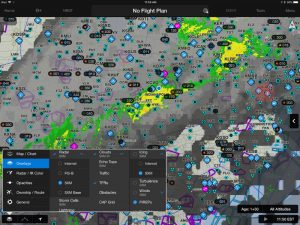
Some app updates bring stunning new features, like synthetic vision or major new hardware integrations. Others focus on the less exciting but equally important job of improving the existing tools, with new user interfaces or design tweaks. The latest version of Garmin Pilot (9.1.4) is in the latter camp, but the updates are well thought out and helpful. Here’s a look at what’s new.
Connext
Perhaps the major focus for Garmin over the last 18 months has been their Connext program, which allows the app to connect to a wide variety of avionics. This includes panel-mount equipment like the FlightStream and GTX 345 and portable receivers like the new GDL 52, which means Garmin Pilot can display in-flight weather, attitude information, SiriusXM audio, and much more.
Given this rapid expansion of options, it’s not surprising that the app itself had gotten a little difficult to use in places. Garmin took aim at this issue in this update, with a number of small changes that save time or make it easier to track the status of your connected devices.
First up is a new way to manage map layers. Garmin offers four different options for radar: Internet (which works on the ground), FIS-B (the ADS-B radar imagery), SXM (SiriusXM composite reflectivity), and SXM Base (the lowest tilt radar reflectivity). One scenario that can lead to unnecessary screen taps is when you switch from one source to another. For example, if you’re looking at internet radar on the ground before flight, then you get in the airplane (where you have a SiriusXM receiver), you’ll see the dreaded “No radar” warning. You have to manually switch from internet to SXM – a small thing, but a nuisance. Now the app automatically detects the weather source and turns on the appropriate layer, so you never have to make the switch manually. It’s one of those “it just works” features we like.
Along the same lines, Garmin Pilot now considers your aircraft flight plan when displaying weather layers that have different altitude options. In the example below, the app will default to showing in-flight icing for 3000 feet – the altitude specified in the preflight plan.
Radar is probably the most important weather product for pilots, but it does have its limitations, especially when it comes to coverage areas. Radar sites simply can’t reach the entire world, so Garmin Pilot now clearly displays gaps in radar coverage. This makes it much easier to determine whether there is no precipitation or no ground-based radar in the area. This is on by default for radar layers.
Here’s the coverage area for Canadian radar (delivered via SiriusXM), for comparison:
This version also includes a new, integrated Connext dashboard, accessed from the Connext menu option. This consolidates all the key information so you can see – at a glance – important status information about ADS-B reception, SiriusXM signal strength, GPS position, firmware, battery life and more. It’s the go-to page for troubleshooting, too.
Flight Data Log transfer
Garmin Pilot has offered a digital logbook and data logging for some time, but the latest version of the app really makes this feature more useful. Now the app, when connected to a data logger like the GDL 52, will automatically record key flight information.
After the data logger records the information and transfers it to the app, Garmin Pilot can upload this information to the Fly.Garmin.com website after landing. From here, you can access your electronic logbook and even play back flights. There’s a sectional chart, simulated attitude indicator (if your data logger records this information), speed/altitude graphs and more. It’s quite easy to use once it’s enabled, and it’s pretty handy for reviewing training or proficiency flights.
Quick access buttons
One feature we really like in Garmin Pilot is the quick access buttons in the top menu bar. These allow you access to key features from any screen on the app: Home, Direct-to, Nearest, and Emergency. So even if you’re buried on a settings page, you can tap Nearest if the engine starts running rough. In the latest version, the Direct-to pop-up has been enhanced, with options for navigating to a waypoint you searched for, a waypoint on your current flight plan, recent waypoints, nearest waypoints or user waypoints you have created. It’s fast and simple.
Version 9.1.4 has plenty of other additions, including more Cessna, Mooney, and Piper aircraft models in the Library. The update is a free update in the iTunes App Store. An annual subscription to Garmin Pilot starts at $74.99.
Source: Ipad appsGarmin Pilot refines user interface with version 9.1.4







